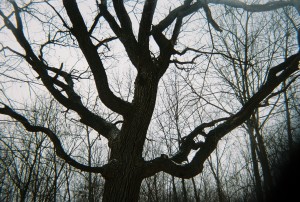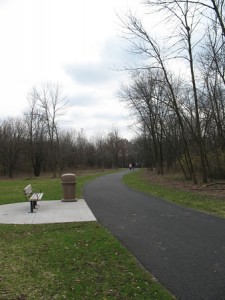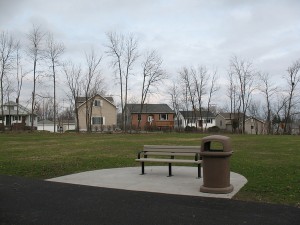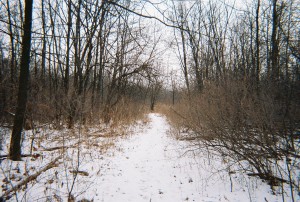
A year and a half ago, I wrote an op-ed column in the Joliet Herald-News (reprinted later on this blog) about an obscure tract of urban forest in Joliet called Teale Woods. Heretofore an overgrown and litter-strewn city woodland, the place nevertheless possessed an air of mystery and enchantment.
No doubt my fascination with this humble woodland was partly due to its namesake, Edwin Way Teale (1899-1980), a Joliet native and one of America’s foremost nature writers and photographers during the 20th century. A skilled naturalist and brilliant observer of plants, animals, and human nature alike, Teale’s eloquent descriptions of the natural world included not just remote wilderness areas, but everyday landscapes familiar to us all — backyards, farms, even urban spaces.

I like to think Teale would’ve found much here to appreciate and value. He had a knack of seeing wonderful things — whether a locally rare bird species making its spring migration, or a beautifully-patterned lichen on the rough bark of an oak tree. Such treasures abound if we take the time to notice them, even in ecologically compromised patches of urban nature.
Not long after my March 2010 article appeared, the Will County Forest Preserve District revealed a Preserve Improvement and Management Plan (pdf) to convert Teale Woods into a 15-acre recreational space, and then solicited public input on their ideas. I was one of seven people to provide written comments that summer, and I urged the WCFPD to avoid over-developing the site and keep the woodland as natural in appearance as possible, in accordance with the spirit of conservation espoused by Teale in his decades of writing about and advocating on behalf of the environment. This fall, the Forest Preserve completed $100,905.50 worth of work building a 0.3-mile paved trail and clearing a large lawn area at the trail head. It’s fair to say, then, that I have a vested interest in the results of these labors.
I should emphasize at this point that I unequivocally support the Forest Preserve’s untiring efforts in acquiring open space, providing outdoor recreation opportunities, educating citizens, and restoring native ecosystems. The WCFPD is the driving force for environmental conservation in Will County as well as a major contributor to its citizens’ quality of life. I have deep respect and sincere appreciation for the work of the Forest Preserve and the many preserve units my family and I visit and enjoy regularly.
Nevertheless, I feel that the development of Teale Woods has missed the mark.
In place of the narrow footpath that once afforded intimacy with the woods is a winding stretch of 10-foot-wide pavement that resembles a road more than a trail. Such an “improvement” feels like overkill within such a small tract of land, where scale is important and every square yard of green space counts.

While it’s supposed to be accessible, parts of the path are so steeply sloped that it’s frankly hard to imagine a person in a non-motorized wheelchair being able to traverse it comfortably. Nor is the path well-suited for biking, for unlike many other preserve trails elsewhere in Will County the trail is extremely short (just a third of a mile) and goes literally nowhere: from the Center/Theodore intersection down to traffic-choked Route 53/Broadway, well north of the existing trail segment within Joliet’s Broadway Greenway. The contrast of this stubby and isolated trail with the continuous trail networks throughout the Rock Run and Theodore Marsh preserves on the far West Side is striking, to say the least.
Just as disappointing is the unattractive and poorly-placed bench on an incongruous concrete pad near the public access at Theodore and Center Streets. Marooned within an enlarged lawn area that was bulldozed of shrubs and small trees, this uninviting “rest stop” has a decidedly uninspiring view of a garbage can and the blacktopped path.

The cleared meadow may have been populated formerly by scrubby non-native plants of little ecological value, but I’m not sure the open space as currently conceived is much better. What’s lost now is the visual buffer the imperfect woods provided along busy Theodore Street, which also effectively shielded the preserve from nearby traffic noise. Now the clearing merely feels exposed and lonely, and of dubious value as a recreational space. For what? one is inspired to ask. Instead, I’d advocate using this area as a prairie restoration site, as has been done on many other Preserve holdings.
Teale Woods is still a valuable green space in the heart of Joliet’s urban core. But in sacrificing modest and aesthetically-sensitive design for the dubious recreational values of a road-like trail and a turfgrass field, its stewards have compromised the forest’s fundamental character.

I’m not exactly sure what Edwin Way Teale would think of the woods and the changes that have occurred these last few months. But I seriously doubt he’d be much impressed.
This is a revised and expanded version of my regular op-ed column that appears today as “Improvements” Strip Forest of Its Greenery (Sunday 18 December 2011) in the Joliet Herald-News. More information on the Will Country Forest Preserve District’s development plan for Teale Woods can be found here. You can view some photos of the preserve’s transformation and its finished state from this fall.